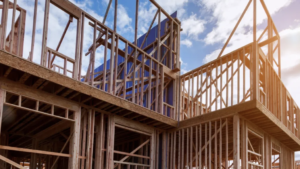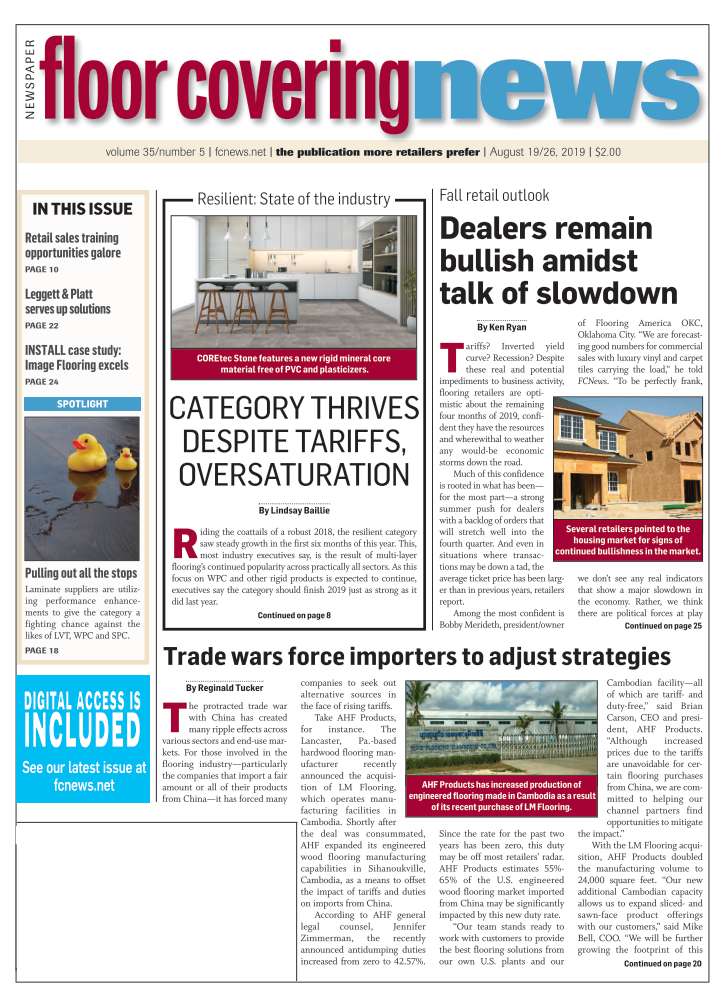By Reginald Tucker

The protracted trade war with China has created many ripple effects across various sectors and end-use markets. For those involved in the flooring industry—particularly the companies that import a fair amount or all of their products from China—it has forced many companies to seek out alternative sources in the face of rising tariffs.
Take AHF Products, for instance. The Lancaster, Pa.-based hardwood flooring manufacturer recently announced the acquisition of LM Flooring, which operates manufacturing facilities in Cambodia. Shortly after the deal was consummated, AHF expanded its engineered wood flooring manufacturing capabilities in Sihanoukville, Cambodia, as a means to offset the impact of tariffs and duties on imports from China.
According to AHF general legal counsel, Jennifer Zimmerman, the recently announced antidumping duties increased from zero to 42.57%. Since the rate for the past two years has been zero, this duty may be off most retailers’ radar. AHF Products estimates 55%- 65% of the U.S. engineered wood flooring market imported from China may be significantly impacted by this new duty rate.
“Our team stands ready to work with customers to provide the best flooring solutions from our own U.S. plants and our Cambodian facility—all of which are tariff- and duty-free,” said Brian Carson, CEO and president, AHF Products. “Although increased prices due to the tariffs are unavoidable for certain flooring purchases from China, we are committed to helping our channel partners find opportunities to mitigate the impact.”
With the LM Flooring acquisition, AHF Products doubled the manufacturing volume to 24,000 square feet. “Our new additional Cambodian capacity allows us to expand sliced- and sawn-face product offerings with our customers,” said Mike Bell, COO. “We will be further growing the footprint of this plant in 2020 to the tune of 50,000 square feet of total capacity.”
Other major suppliers with manufacturing interests in China have moved to divert manufacturing as a result of the imposition of tariffs on that country. In the case of CFL Flooring, in fact, the company proactively announced major changes in its sourcing strategy when it first saw the writing on the wall last year.
Back in September 2018, the company announced plans to establish three new, fully integrated production facilities outside of China. Now up and running at near-full capacity, the plants crank out products that are not subject to the tariffs imposed by the U.S. government.
“These manufacturing initiatives in countries outside of China mark the beginning of a more global expansion of our company,” said Thomas Baert, president. “CFL has grown into a family of close to 3,000 employees, and we are very committed to providing a platform for our customers to take market share in these changing times.”
Tom Van Poyer, CEO of CFL Flooring, said the alternative factories will be dedicated to the production of laminate flooring, SPC, WPC and LVT/P. “We are committed to make our partners stronger than ever in this ever-changing and challenging business environment, and we feel we are far ahead in proactively finding solutions for our customers,” he said. “We will continue to go the extra mile to bring the most innovative and differentiated products to the marketplace.”
Industry experts specializing in global trade issues believe the exodus of manufacturing operations out of China could change the dynamic significantly. So said Harry Moser, founder of The Reshoring Initiative, an organization that advocates bringing manufacturing jobs back to the U.S. “There has been a series of articles about work flooding out of China, with most of it going to Southeast Asia to places like Vietnam, Cambodia, Indonesia, Malaysia and India,” he said.
But he’s not expecting any of these countries to become manufacturing powerhouses overnight—at least not on the same scale as China. “You don’t have to move too much work out of China to flood Vietnam with business,” Moser said, citing Vietnam’s population of roughly 96 million people compared to China’s 1.3 billion people. “Also, Chinese wages were rising 10%-15% a year for the last 15-20 years. There are simply not enough workers in Vietnam to take the flood of work and not see the same wage growth patterns we’re seeing in China. So, five years from now, you might have to leave Vietnam. And by that time maybe Cambodia has become too expensive to produce.”
In the interim, statistics show Vietnam is by far the biggest winner from the U.S.-China trade war so far as importers look to divert their orders to bypass higher tariffs. The Southeast Asian nation, which shares a border with China, gained orders from trade diversion on tariffed goods equal to 7.9% of gross domestic product in the year through the first quarter of 2019, according to a study by Nomura Holdings economists Rob Subbaraman, Sonal Varma and Michael Loo. Taiwan is a distant second among the winners, with gains equivalent to 2.1% of GDP. Both economies gained far more from U.S. tariffs on China than from Chinese duties on the U.S.
Unintended consequences
The move to divert manufacturing to countries outside of Asia brings its own set of challenges. Recent published articles show Vietnamese authorities found dozens of fake product-origin certificates and illegal transfers by companies trying to sidestep U.S. tariffs on everything from agriculture to textiles and steel, a Bloomberg report stated. In response, Vietnam pledged to increase penalties on trade-related fraud.
“It’s always a cat-and-mouse game,” said Fred Burke, managing partner at law firm Baker & McKenzie in Vietnam. “As long as people are willing to take risks in search of those arbitrages of, say, 25%, it’s very difficult to enforce.”
All the more reason, advocates of U.S. production say, to aggressively promote products made domestically. “It’s not that the U.S. is the best place in general to produce, but it is, in many cases, the best place to make products that are going to be sold here in the U.S. market,” Moser told FCNews. “U.S. companies are much more competitive selling flooring in the U.S. than they would be exporting to China, Germany, etc., because they don’t have to deal with duties, freight charges, inventory and so forth. U.S. manufacturing can be 15% more expensive than Chinese and still be the better choice for supplying the U.S. market.”
And that’s fine for U.S. producers like AHF Products, which manufactures 100% of its solid hardwood flooring in America. In fact, the company operates six manufacturing operations across the U.S. “Considering the current challenges associated with tariffs and duties, AHF Products offers a significant degree of certainty to serving customers with its strong domestic manufacturing capabilities and scale,” Carson said. “This includes greater product control, faster lead time, lower transportation costs, predictable prices and a Made-in-the-USA story.”
AHF is not alone in leveraging its domestic strengths. Armstrong Flooring, which operate plants in Pennsylvania, Illinois, Oklahoma, Mississippi and California, has launched a campaign to emphasize its domestically manufactured products—goods that won’t be subject to a price increase as a result of these increased tariffs.

